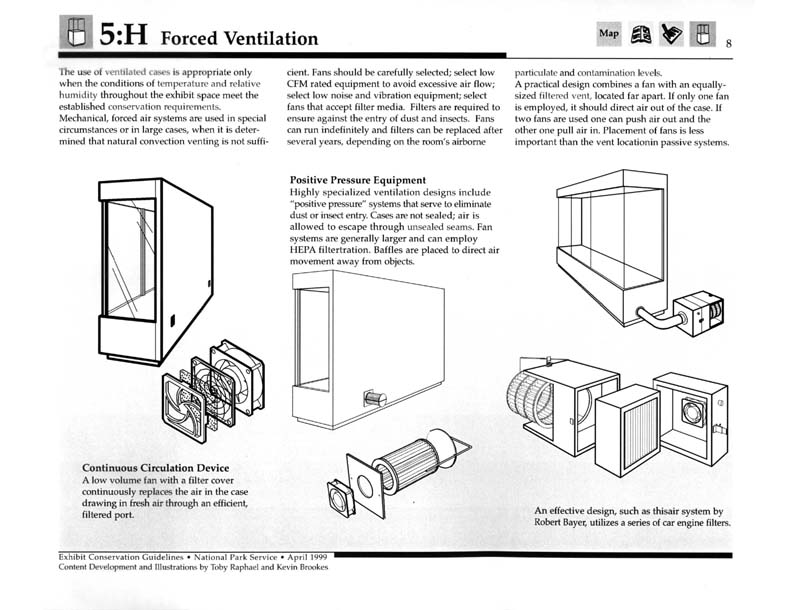Jan 2000 Volume 22 Number 2
![]()
![]()
Jan 2000 Volume 22 Number 2
EXPLORING THE CONFLICT
The museum field has long been confronted with an ongoing challenge -- polarization between its museum exhibition and conservation specialists. Unfortunately, as a result of this conflict, cooperation and collaboration between these specialists has been missing over the last decade.
It is equally true that the conventional exhibition process itself, as practiced by most museums:
For exhibit planners, designers, and fabricators the preservation requirements and conservation features necessary to produce responsible exhibits appear complex and even elusive. There is no single resource where guidelines can be found, no source where alternative techniques or applications can be studied. Inaccess to this body of knowledge has taken its toll in both professional working relationships and the final product -- the museum exhibit itself.
The problems resulting from this conflict have manifested themselves in:
Many conservators believe that their institutions' exhibit process does not adequately or systematically incorporate the preservation needs of the collections going onto display.
Preservation specialists often believe they see the long-term picture in contrast to the exhibit specialists who focus on a short-term use. Many exhibit designers believe, however, the manner in which conservation is introduced often compromises exhibit design and effectiveness, and disregards the impact on a project's budget.
When polled, exhibit designers readily point to several problems with many conservation recommendations:
Communication Form and Content
Setting of Impractical Requirements
When polled, conservators readily point to several problems associated with working with exhibit designers:
Insensitivity and Self-interest
A myriad of factors has contributed to this conflict. The dilemma, however, is clearly rooted in the central debate over "preservation" versus "use" of collections.
Museum exhibition is where the conflicting responsibilities of these professions collide: the museum's obligation not only to "preserve" collections but to "use" them as well.
This conflict is perpetuated by several factors, including:
Just as there is little focus on the exhibit process with in conservation training programs, there is no conservation training available for museum specialists such as exhibit designers. In fact there is a dearth of training altogether.
Collection staff often lack the experience and technical understanding to be able to communicate their needs in ways that fabricators can understand. Conservators rarely learn how to read blue print drawings or feel comfortable using the design/fabrication language of specifications.
An accepted method or approach for developing an exhibit involving museum objects does not exist. Commercial firms and institutions alike are left to define their own critical paths. This often results in an ineffective or chaotic process which adversely affects the end-product.
Throughout this decade it has become increasingly clear that a systematic resource was needed to assist museums and their exhibit contractors incorporate conservation into the exhibit process. A set of guidelines should work to:
To address this exhibit problem the Division of Conservation of the National Park Service embarked on a major preventive conservation project to create a preservation framework and tool for both its personnel and the exhibit specialists from whom the NPS procures services. The objective was to develop a set of practical exhibit guidelines that would systematically incorporate preservation criteria into the exhibition development process.
The fact is that safe and appropriate display of collections does not have to compromise good design or effective interpretation. The challenge is to design and produce preservation-responsible exhibits that also attract and inform the public.
The long-term goal was to create a program that would ensure preservation-responsible exhibits by:
Years of producing exhibits have taught us that preservation- responsible exhibits require a close, constructive working relationship between exhibit and conservation specialists.
Trust and a sense of shared responsibility for collection preservation are invaluable parts of the equation. Only by involving conservation early and systematically throughout the process, can a museum ensure responsible planning, design, and production.
The NPS chose an interdisciplinary approach, working closely with exhibit designers and fabricators. The Park Service used its own exhibit design staff and a design contractor, Nash Brookes Inc. Exhibit conservator Nancy Davis also made a major contribution.
The first generation of our guidelines has been completed and is
entitled Exhibit Conservation Guidelines: Incorporating
Conservation into Exhibit Planning, Design and Production.
It does not attempt to create a set of definitive standards. Instead, it presents principles and techniques illustrating how conservation criteria can be successfully met in exhibits.
The Guidelines include:
Due to its diverse audience the Guidelines enlisted several different communication formats: a narrative format provides the framework for introducing each individual guideline and its discussion points; technical notes are intended to supplement the guidelines with examples; and technical drawings are included to illustrate conservation details regarding exhibit case design.
(The figures on these pages are from the technical drawings section.)
For ease of use the Guidelines has been produced as an electronic publication, presented in a CD-ROM format. The viewer can easily access previously difficult-to-find information in the narrative section and move directly through hyperlinks to pertinent technical references.
Feedback from our conservation staff and exhibit specialists (including planners, curators, designers, and exhibit fabricators) has been extremely positive. By clarifying conservation concerns, presenting tangible guidelines with supplemental examples, and identifying a methodical process for incorporating conservation, we have greatly enhanced the ability of exhibit specialists to prevent needless damage to objects going onto exhibit.
Collaboratively, we have taken the first step towards resolving a significant exhibit conflict.